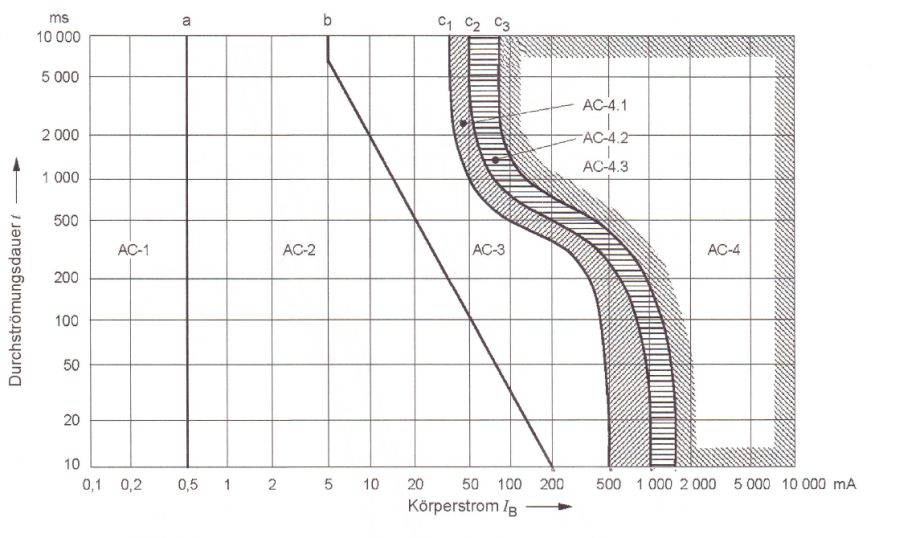Background information for limit values
Human reactions on electric current depend on the intensity and duration of current flow through the body as well as on the current path. They range from subtle perception up to a fatal event caused by interruption of the normal heart activity. For evaluation of a possible hazard due to a current flow through the body, the following thresholds are valid which depend on different physiological effects. The thresholds depend on the size of contact area, skin moisture and physiological characteristics of the individual. The definitions of the thresholds are given in the following:
- Threshold of perception: the minimal value of the current through the body that can be perceived by the person.
- Threshold of reaction: the minimal value of the current through the body that induces involuntary muscle contractions.
- Threshold of let-go: the maximal value of the current through the body at which an individual is able to release the energized contact area (see Parameters for effects of electric current). There is no threshold of let-go for direct currents, only at the start and the end of the current flow which leads to painful and seizure-like muscle contractions.
- Threshold of ventricular fibrillation: the minimal value of the current through the body that causes ventricular fibrillation. The threshold of ventricular fibrillation depends on state of the heart function as well as on electrical parameters (e.g., amplitude of current, duration of current flow, current path). For shock durations below one cardiac cycle, the effect occurs when the electric shock falls within the vulnerable period (part of the heart cycle in which ventricular fibrillation can be induced).
In the following figure of the technical specification TS IEC 60479-1 (2005) there are four current zones dependent on the duration of the current flow which show different physiological effects such as perception, involuntary muscle contractions, or ventricular fibrillation which differ in the potential human hazards. The figure is valid for alternating current (AC) in the frequency range of 15 – 100 Hz with a current path of the left hand to both feet. The classification of the zones is given in the following:
- AC-1: perception possible, however usually no startle reaction (up to 0.5 mA, curve a)
- AC-2: perception and involuntary muscle contractions possible but mostly no harmful physiological effects (curve a - curve b). Curve b marks the let-go threshold.
- AC-3 b-c: Strong involuntary muscle contractions, reversible disturbances of the heart function, mostly no organic damages (curve b to curve c1)
- AC-4: pathophysiological effects (e.g. cardiac arrest, breathing arrest) possible (above curve c1):
• c1-c2: probability of ventricular fibrillation increasing up to about 5%
• c2-c3: probability of ventricular fibrillation increasing up to about 50%
• above c3: probability of ventricular fibrillation above 50%

Figure 20 of DIN IEC/TS 60479-1 (VDE V 0140-479-1), ed. 2007 in German, reproduced with permission 72.016 of DIN Deutsches Institut für Normung e.V. and VDE Verband der Elektrotechnik Elektronik Informationstechnik e.V.. A separate permission is required for further distribution. For application of the standards the versions of the latest edition date are relevant, which are available at VDE VERLAG GMBH, Bismarckstr. 33, 10625 Berlin, Germany, www.vde-verlag.de, and Beuth Verlag GmbH, 10772 Berlin, Germany.
The figure with the different hazard areas shows that currents up to 0.5 mA are not or nearly not perceived independent of the duration of current flow. The let-go threshold is time-dependent and is in the range of 5 mA at duration of current flow of more than 6 seconds up to 200 mA at duration of 10 milliseconds. Furthermore, the figure reveals that already small currents of about 40 mA may lead to ventricular fibrillation and therefore to the death of an individual if the current flow through the human body is longer than 2 seconds.
Since permissible body currents are not measureable in everyday life, the limit values for permissible touch voltages for several conditions for AC and DC are to be calculated. Data on the body resistance under different conditions (e.g. skin moisture, size of contact area (see Parameters for effects of electric current) are required. The technical specification IEC 60479-1 (2005) on the possible effects of electric current on human beings and livestock comprises the required data for calculation of the permissible touch voltages.